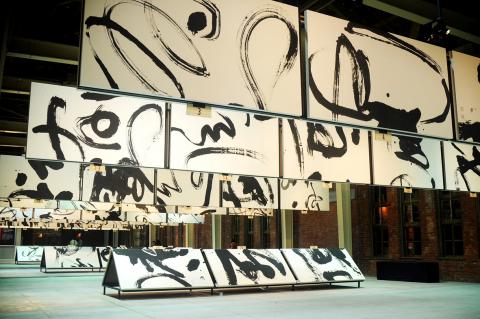The calligraphy of Tong Yang-tze (董陽孜) is known for its expressiveness and movement, with vivid brushstrokes that seem to dance across the paper. Silent Symphony, Musical Calligraphy (無聲的樂章.有聲的書法), an exhibition showing at Huashan 1914 Creative Park (華山1914) through Dec. 10, pays tribute to Tong’s work. In addition to 100 of her pieces, an interactive art installation by pop-rock band Mayday (五月天) vocalist Ashin (阿信, real name Chen Hsin-hung, 陳信宏) is meant to help younger viewers appreciate the beauty of traditional Chinese calligraphy.
Born in Shanghai in 1942, Tong began studying calligraphy when she was just 8 years old. She received a Master of Fine Arts from the University of Massachusetts, Amherst, and her work is known for blending Western aesthetics with traditional calligraphy forms and techniques.
Ashin’s collaboration with Tong represents a return to his creative roots. Before becoming a musician, he studied art and earned a degree in interior design from Shih Chien University (實踐大學). Called Musical Calligraphy, the multimedia installation features an enclosure made of glass. Once inside, viewers hear a song written by Ashin as the lyrics appear in the form of an animated version of Tong’s calligraphy, highlighting the relationship between the brushstrokes and the rhythm of the music.

Photo courtesy of Trendmicro
The exhibit is accompanied by a series of discussions. Tomorrow, Demos Chiang (蔣友柏) will talk about the relationship between calligraphy and graphic design, while on Dec. 3 lyricist Vincent Fang (方文山), best known for his collaborations with Jay Chou (周杰倫), will discuss using Tong’s calligraphy as inspiration for a song. Ashin will give viewers a look into the creation of Musical Calligraphy on Dec. 10, the last day of the exhibit.
An online interactive art project overseen by Trendmicro, the exhibition’s sponsor, goes live today. The Web site, called 10,000 More (萬人墨象, www.10000more.com), gives visitors a chance to see pieces by Tong online, as well as enter a drawing to win a piece of her calligraphy.

The canonical shot of an East Asian city is a night skyline studded with towering apartment and office buildings, bright with neon and plastic signage, a landscape of energy and modernity. Another classic image is the same city seen from above, in which identical apartment towers march across the city, spilling out over nearby geography, like stylized soldiers colonizing new territory in a board game. Densely populated dynamic conurbations of money, technological innovation and convenience, it is hard to see the cities of East Asia as what they truly are: necropolises. Why is this? The East Asian development model, with

June 16 to June 22 The following flyer appeared on the streets of Hsinchu on June 12, 1895: “Taipei has already fallen to the Japanese barbarians, who have brought great misery to our land and people. We heard that the Japanese occupiers will tax our gardens, our houses, our bodies, and even our chickens, dogs, cows and pigs. They wear their hair wild, carve their teeth, tattoo their foreheads, wear strange clothes and speak a strange language. How can we be ruled by such people?” Posted by civilian militia leader Wu Tang-hsing (吳湯興), it was a call to arms to retake

This is a deeply unsettling period in Taiwan. Uncertainties are everywhere while everyone waits for a small army of other shoes to drop on nearly every front. During challenging times, interesting political changes can happen, yet all three major political parties are beset with scandals, strife and self-inflicted wounds. As the ruling party, the Democratic Progressive Party (DPP) is held accountable for not only the challenges to the party, but also the nation. Taiwan is geopolitically and economically under threat. Domestically, the administration is under siege by the opposition-controlled legislature and growing discontent with what opponents characterize as arrogant, autocratic

When Lisa, 20, laces into her ultra-high heels for her shift at a strip club in Ukraine’s Kharkiv, she knows that aside from dancing, she will have to comfort traumatized soldiers. Since Russia’s 2022 invasion, exhausted troops are the main clientele of the Flash Dancers club in the center of the northeastern city, just 20 kilometers from Russian forces. For some customers, it provides an “escape” from the war, said Valerya Zavatska — a 25-year-old law graduate who runs the club with her mother, an ex-dancer. But many are not there just for the show. They “want to talk about what hurts,” she